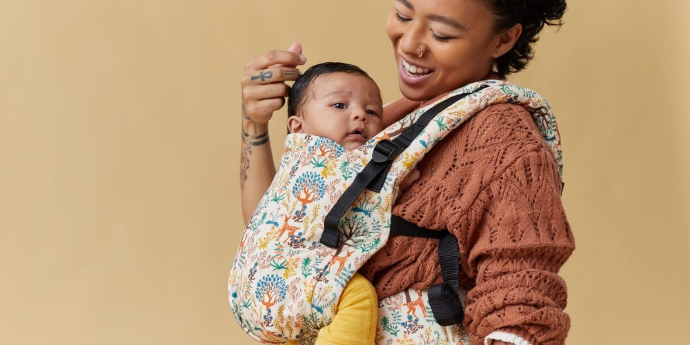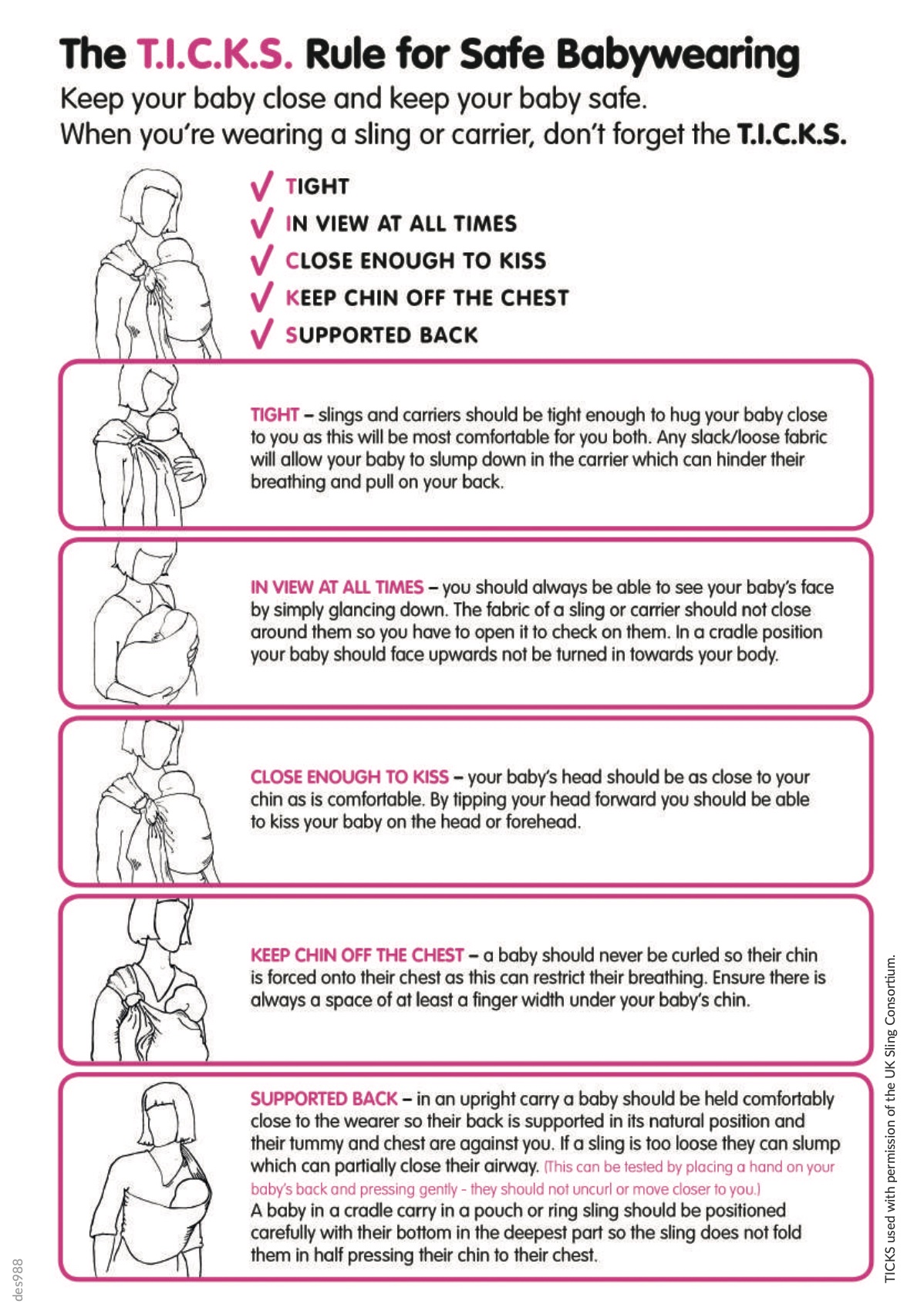
Babywearing Advice
Babywearing is the practice of carrying a baby or young child in a carrier or sling close to your body. It offers numerous benefits for both the parent/caregiver and the baby, including promoting bonding, providing comfort for the baby, and freeing up your hands for other activities.
A sling, wrap or carrier provides comfort and support for your baby and allows you to carry your child hands free. It’s not a new concept and has been practised for centuries in different cultures, however there has been a lot of innovation in Babywearing to make it simpler for the wearer and safer for baby.
There are lots of types of slings so it’s worth finding out about the different styles, and even trying a few before you buy one
Babywearing promotes bonding, supports breastfeeding, can help combat postpartum depression, and so much more. Whether it be Mum, Dad, Grandparents, sibling or any other caregiver, we encourage you to learn more about the benefits of babywearing and explore this beatuful practice as a safe and effective parenting tool.
Carried Babies Cry Less!
Research shows that babies who are carried (either in parents' arms or in a baby sling carrier or wrap) cry LESS. In cultures where babies are carried almost continuously, babies cry much less than those in non-carrying cultures. Having a carrier allows you to be handsfree whilst meeting your babies needs as well as your own.
Babywearing Counts As Tummy-Time!
Tummy-time is important for your baby's physical as well as emotional and intellectual development. It helps them learn to hold their head up, grasp at items to help develop motor skills, and observe the world around them. But you may have noticed that even though it's good for your baby, he may not be a huge fan of tummy-time. It's a serious workout! Wearing your baby will allow your them to exercise his neck, head and back muscles.
Frees Your Hands
Babywearing enables caregivers to to keep baby close and safe while still having both hands free. Caregivers have the freedom to care for other children and tend to everyday tasks while carrying their baby close to their heart.
Bond With Baby
Parenting can be overwhelming and exhausting. You have work to do, there is laundry to be folded, there are errands to run, and you can't always hold your baby when they want to be held. Babywearing benefits you and your baby because it is a great way to connect with your child, provide stimulation for baby, and free up your hands. Babies need verbal interaction and eye contact, just to be reassured that you're there. A babywearing sling can help keep your little one close so that you can manage your day-to-day while still holding baby and providing the closeness they need. Additionally, your baby is "right there" to enjoy whenever you feel like snuggling or kissing!
Good For Baby's Emotional Development
Babies are quickly able to develop a sense of security and trust when they are carried. They are more likely to be securely attached to their care-giver(s) and often become independent at an earlier age.
Enhances Baby's Social Development
By being so close to your body's rhythms, your baby "gets in rhythm" much more quickly. Your heartbeat, breathing, voice and warmth are all familiar. Research has shown how this helps infants to adapt to life outside the womb.
Helps Prevent "Flat-Head" Syndrome
Since the "Back To Sleep" program which was implemented in the early 90's to encourage a safer sleep environment for babies and reduce SIDS we have seen a sharp rise in cases of positional plagiocephaly, or “flat head syndrome”. Whilst babies should always sleep on their back, we also over-using devices such as car seats (other than in the car), swings and bouncy seats and babies are spending a lot of time with pressure on the back of their heads. By regularly carrying your baby in a baby carrier, you reduce the time baby has pressure that is placed on the back of their head, and you will be promoting a healthy and natural head development!
Helps Decrease Risk of Postpartum Depression
Babywearing increases the amount of time spent practicing skin-to-skin with your baby. And when you add the benefits of getting to hold your baby “hands-free” and assistance with breastfeeding, these benefits give a boost of confidence and can help with the transition into motherhood and enhance a new mom's overall mental wellbeing, which research has connected to decreased rates of postpartum depression.
Nurse Discreetly
Babywearing can enhance and promote successful breastfeeding, shielding your baby from outside distractions while nursing. It may take a little practice, but once you get the hang of it, you get to nurse without anyone even noticing. We recommend you first master
Although rare, unfortunately some babies have been injured and even died in baby slings and carriers. A sling’s fabric or fabric from a parent’s clothing can press against a baby’s airways and cause suffocation very quickly. Because babies do not have strong neck control and cannot lift their head, if incorrectly positioned their airway can also become restricted. It is important to ALWAYS follow the TICKS guidelines when Babywearing (see "How to baby wear safely" below)
If your baby was born premature, with a low birth weight or has a medical condition, please discuss the safe use of a carrier or sling with a health professional.
Whichever carrier you chose, make sure to always follow these TICKS guidelines every time you wear your baby, to keep them safe and well supported in their carrier.

The recommended position is known as the M-position. The M-position is where the baby is facing their adult and has their thighs spread around the wearer’s torso. The baby has their hips bent so their knees are slightly higher than their buttocks, or at buttock level with the thighs supported. You can draw an "M" shape from baby's foot up to their knee, down to their bottom, up to their other knee, and down to their foot.
This position is beneficial for correct hip development, and also encourages social development as they are facing their caregiver. It is particularly important if a baby is being held in a sling for long periods of time.
If your baby is outward facing (not recommended before 6m old) you must still maintain this M-position. Baby will look as if they are sitting in the air. This is correct.
Using a sling while breastfeeding is associated with a longer duration of breastfeeding, due to convenience and the increased responsiveness that comes with keeping a baby close throughout the day. It’s important to know how to do it safely though. Do make sure you check the manufacturer’s instructions as some suggest you don’t breastfeed in their slings. Here are our tips:
- Check your baby can breathe easily and their mouth and nose are clear
- Never have fabric holding your baby's head onto the breast, they need to be able to latch/unlatch freely.
- Support your baby at all times.
- Return your baby to a proper carrying position immediately after feeding.
Wraps
These are long pieces of fabric that wrap around you and your baby. You can choose from stretchy or woven varieties. Wraps can be really comfy and versatile although the tying puts some people off, but once you've go the hang of it its easy! Although you must check that the wrap is correctly tied each time, it can be left tied on when your baby has been taken out, which saves some precious minutes.
Stretchy wraps might not be supportive enough for larger babies or those over six months old, but are a favourite for newborns as the fabric stretches and holds so well around baby's body. Woven wraps can be used from birth to toddlerhood and beyond, and worn in lots of different ways. Learning how to tie the knots for woven wraps or use these wraps at all can be more challenging than using some other types of carrier.
Shop our wraps range here
Meh Dais
This type of carrier originated in China. They are a cross between a woven wrap and a soft structured carrier. They are made of what is usually a square or rectangle of fabric with four straps. One set of straps is tied around the wearer’s waist and the other over their shoulders, or sometimes all are tied together. The fabric forms a pocket for the baby. If the waist straps are buckled instead of tied it would be called a "half-buckle".
Suitable from birth, baby can be worn on the front, hip and back, depending on your baby’s age, weight and size. The straps spread the weight over your shoulders and hips through the straps. This means they can be comfortable even when you’re carrying older babies and toddlers.
Shop our Meh Dai range here
Soft structured carriers (SSCs)
Our most popular style of carrier as they are the simplest to use. Once adjusted to your size, simply click the buckles at the wait and shoulders to secure baby into the carrier. The dad's tend to like this style the most too. They have a structured waist and padded shoulder straps that can fasten with buckles or straps and are generally very supportive on your back. Although easy to use, it's still important to adjust the straps to fit you/baby to ensure an ergonomic fit.
Some styles are suitable from birth, some from 6m old or require an extra insert to make it suitable from birth. The upper weight limit in the manufacturer’s instructions might allow you to carry more weight and therefore an older child. This can come in handy if you need to carry your little one when they’re tired at the end of a long walk.
Shop our SSC range here
Ring slings
Ring slings are worn over one shoulder. Ring slings are a piece of cloth with two rings sewn at one end, much like a basic belt loop. The free end is looped through the rings, forming a pouch for the baby, with the tail of the fabric hanging down. Using a ring sling takes practice to get it right, however once mastered, they are extremely convenient as they fold up very small, and allow for a lovely hip carry which is a great alternative to outward facing.
Similar to Ring Slings, Pouches are made of one folded length of material that forms a pocket for the baby. The downside to this is the length is not adjustable so you might not get a good, safe fit for your baby.
Shop our Ring Sling range here